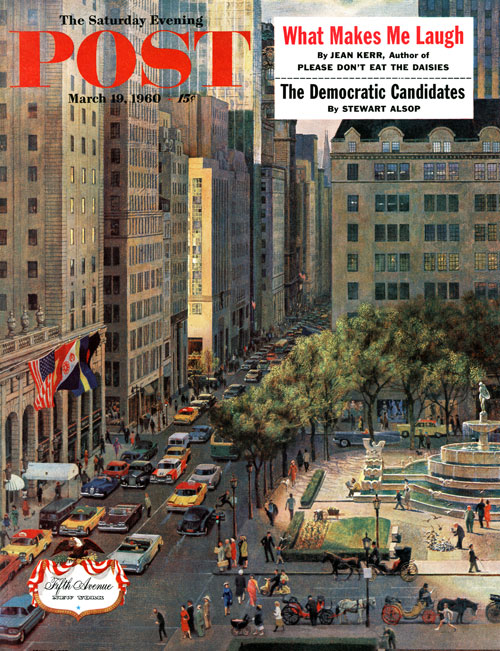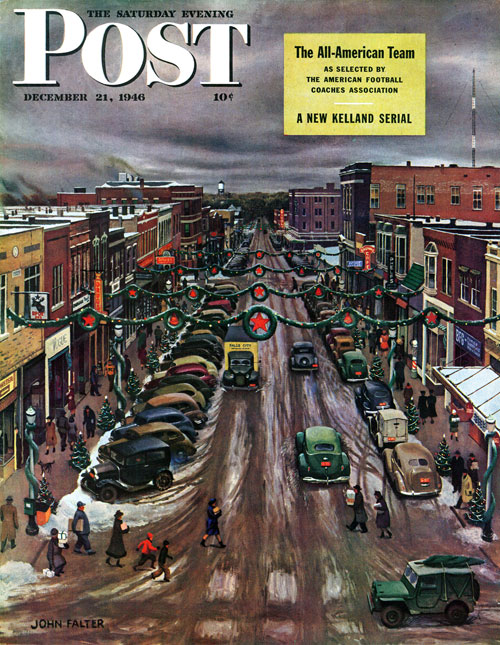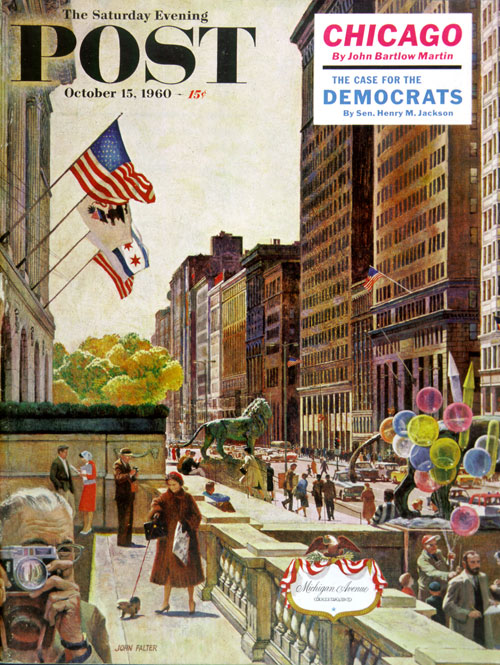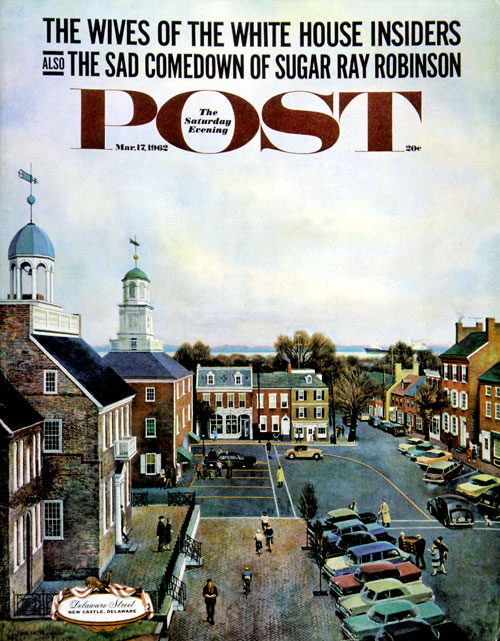Classic Covers: Can You Guess the City?
We admit these beautiful cities look different now than they did in 1946 or 1960, but these covers by artist John Falter are still a treat. How many can you guess?
Fifth Avenue

John Falter
March 19, 1960
This is one of the most famous streets in America, circa 1960. Next hint: the April sun in shining on the windows of Tiffany’s. Joggers, cars, horse and buggies, feeding the pigeons – so much detail that it was actually a fold-out cover. You can study it further or read on for the answer, as if you didn’t know: New York’s Fifth Avenue. By the way, you can click on any cover for a close-up.
Falls City, Nebraska at Christmas

John Falter
December 21, 1946
A few weeks ago, Ruth Nixon wrote to us asking for John Falter covers. This one is of Falter’s (and Ruth’s) hometown of Falls City, Nebraska, Christmas time 1946. The future Post cover artist worked on this very street in his father’s clothing store. He had the exalted title of “pants runner”; he ran trousers from the store to the tailor’s to get them shortened. You have to love the cars in this one. Thanks so much, Ruth, for giving us the idea for this segment!
Monument Circle

John Falter
October 28, 1961
I knew this one instantly! I’d like to think it’s because I’m so darned smart, but actually it’s because I’ve worked in downtown Indianapolis and have had lunch out on Monument Circle on many fine days. Dedicated in 1902, the Soldiers and Sailors Monument is at the very heart of downtown. Again, the minute artist’s detail: A teeny-tiny group of school children are viewing the beautiful statues of soldiers and sailors – which, unfortunately, you have to be quite close to see how exquisite they are. The beautiful English Gothic Christ Church still stands, I’m happy to say, as does the neighboring Columbia Club building. Indy thanks you for this one, Mr. Falter.
Kansas City

John Falter
September 23, 1961
If this cover is any indication, this is one of the prettiest cities around. “Spanish architecture in Missouri?” the editors asked. “If such a state of affairs seems peculiar, consider that the unpredictable Show Me state even has a town named Peculiar, some twenty miles south of here.” “Here” is lovely Kansas City in 1961. The charming community of shops pictured here was conceived and built by Jesse Clyde Nichols (1880-1950) to whom the fountain in the foreground is a memorial.
Peachtree Street

John Falter
June 25, 1960
Let’s head south and see what people are doing on this fine June day in 1960. Construction workers are constructing (right of that big tree), pedestrians are pedestrianing, and traffic is flowing well on Peachtree Street in Atlanta. Get out the magnifying glass again, because the editors identified one of the teeny-tiny people to the far lower left: “ the gentleman on crutches is Ernest Rogers, Atlanta Journal columnist and the popular ‘Mayor of Peachtree Street’”. More editorial info: “In the early nineteenth century this was a sinuous ridgetop trail leading to an Indian settlement known as The Standing Peachtree; today it’s the main artery in the economic capitol of the South. That towering tree in the foreground is an American elm. Our scene contains no peach trees—they don’t thrive in downtown Atlanta.”
Michigan Avenue, Chicago

John Falter
October 15, 1960
We must not forget the Windy City. Again, there was so much wonderful stuff to show, this was a fold-out cover, but we can show you half. This is Michigan Avenue, looking north toward the Tribune Tower and the Wrigley Building. Where, you ask? Again, the incredible detail: “The Wrigley Building and environs are reflected in the camera lens at left”. You can tell it’s a crisp autumn day from the coats being worn and the changing leaves on the tree to the left. Another identifiable pedestrian: “The whiskered gent with the sketch pad is the late Louis Sullivan, Frank Lloyd Wright’s mentor and an architect who helped reshape the face of this frisky city.”
Town Square, New Castle, Delaware

John Falter
March 17, 1962
I must add one more because this is such a charming cover. New Castle, Delaware was not a big city (pop. 4469 at the time of this 1962 cover), but it won over artist Falter. The editors shared some interesting history: “Founded in 1651, it was William Penn’s landing place when he came to America at in 1682. Penn is thought to have spent a night in the house at the extreme right of our cover. The spire atop the Court House (left foreground) was used as the center of a twelve-mile radius in part of the 1763-67 survey—to settle a boundary dispute—that resulted in the Mason-Dixon Line.” You thought the Mason-Dixon line was way down South, didn’t you? Nope. Personally, I’m interested in the people at the lower right of the cover trying to fit a lovely antique into a car trunk. It makes me want to go antiquing in New England. Well, maybe with a bigger vehicle.